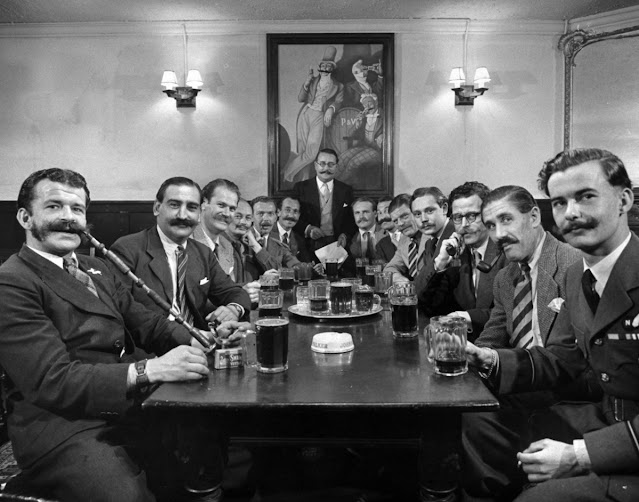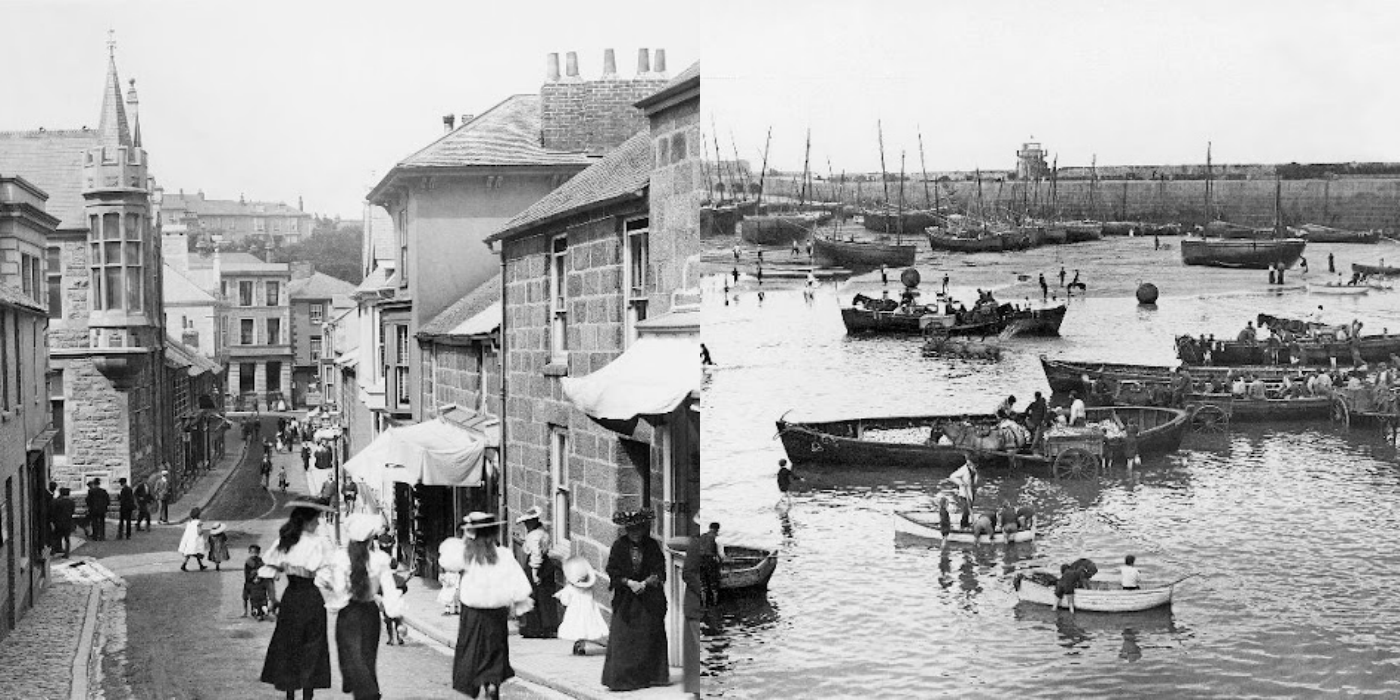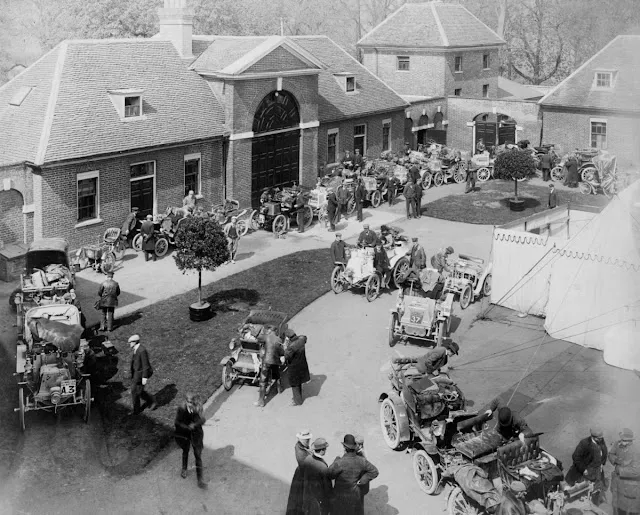The term Dust Bowl was coined in 1935 when an AP reporter, Robert Geiger, used it to describe the drought-affected south-central United States in the aftermath of horrific dust storms.
Historically, the Dust Bowl was a period of severe dust storms that greatly damaged the ecology and agriculture of the American and Canadian prairies during the 1930s.
Severe drought and a failure to apply dryland farming methods to prevent the aeolian processes (wind erosion) caused the phenomenon. The drought came in three waves: 1934, 1936, and 1939–1940, but some regions of the High Plains experienced drought conditions for as many as eight years.
As high winds and choking dust swept the region from Texas to Nebraska, people and livestock were killed and crops failed across the entire region.
The Dust Bowl intensified the crushing economic impacts of the Great Depression and drove many farming families on a desperate migration in search of work and better living conditions.
.jpg)
Family walking on highway, five children. Started from Idabel, Oklahoma. Bound for Krebs, Oklahoma. Pittsburg County, Oklahoma. In 1936 the father farmed on thirds and fourths at Eagleton, McCurtain County, Oklahoma. Was taken sick with pneumonia and lost farm. Unable to get work on Work Projects Administration and refused county relief in county of fifteen years residence because of temporary residence in another county after his illness.
The photography of Dorothea Lange, as shown in this collection, is as closely associated with American farmers’ struggle against drought and dust in the Depression era.
In the depths of the worldwide Depression, 1933, some fourteen million people in the U.S. were out of work; many were homeless, drifting aimlessly, often without enough food to eat. In the midwest and southwest drought and dust storms added to the economic havoc.
During the decade of the 1930s some 300,000 men, women, and children migrated west to California, hoping to find work. Broadly, these migrant families were called by the opprobrium “Okies” (as from Oklahoma) regardless of where they came from.
They traveled in old, dilapidated cars or trucks, wandering from place to place to follow the crops. Lange began to photograph these luckless folk, leaving her studio to document their lives in the streets and roads of California.
She roamed the byways with her camera, portraying the extent of the social and economic upheaval of the Depression.
Lange developed personal techniques of talking with her subjects while working, putting them at ease and enabling her to document pertinent remarks to accompany the photography. The titles and annotations often revealed personal information about her subjects.
.jpg)
A Dust Bowl farm. Coldwater District, north of Dalhart, Texas. This house is occupied; most of the houses in this district have been abandoned.
Between 1930 and 1940, approximately 3.5 million people moved out of the Plains states. In just over a year, over 86,000 people migrated to California.
This number is more than the number of migrants to that area during the 1849 gold rush. Migrants abandoned farms in Oklahoma, Arkansas, Missouri, Iowa, Nebraska, Kansas, Texas, Colorado, and New Mexico, but were often generally referred to as “Okies”, “Arkies”, or “Texies”.
Terms such as “Okies” and “Arkies” came to be known in the 1930s as the standard terms for those who had lost everything and were struggling the most during the Great Depression.
However, not all migrants traveled long distances; most migrants participated in internal state migration moving from counties that the Dust Bowl highly impacted to other less affected counties.
So many families left their farms and were on the move that the proportion between migrants and residents was nearly equal in the Great Plains states.
.jpg)
Drought-stricken farmer and family near Muskogee, Oklahoma. Agricultural day laborer. Muskogee County.
An examination of Census Bureau statistics and other records, and a 1939 survey of occupation by the Bureau of Agricultural Economics of about 116,000 families who arrived in California in the 1930s, showed that only 43 percent of Southwesterners were doing farm work immediately before they migrated.
Nearly one-third of all migrants were professional or white-collar workers. Specifically for farmers, while some of them had to take on unskilled labor when they moved, leaving the farming sector commonly led to greater social mobility in the future as there was a far greater likelihood that migrant farmers would later go into semi-skilled or high-skilled fields which paid better.
.jpg)
Wagoner County, Oklahoma.
Non-farmers experienced more downward occupational moves than farmers, but in most cases, they were not significant enough to bring them into poverty, because high-skilled migrants were most likely to experience a downward shift into semi-skilled work.
While semi-skilled work did not pay as well as high-skilled work, most of these workers were not impoverished. For the most part, by the end of the Dust Bowl, the migrants generally were better off than those who chose to stay behind according to their occupational changes.
After the Great Depression ended, some migrants moved back to their original states. Many others remained where they had resettled. About one-eighth of California’s population is of Okie heritage.
.jpg)
The highway going West. U.S. 80 near Lordsburg, New Mexico.
The crisis was documented by photographers, musicians, and authors, many hired during the Great Depression by the federal government. For instance, the Farm Security Administration hired numerous photographers to document the crisis.
The work of independent artists was also influenced by the crises of the Dust Bowl and the Depression. Author John Steinbeck, borrowing closely from field notes taken by FSA worker and author Sanora Babb, wrote The Grapes of Wrath (1939) about migrant workers and farm families displaced by the Dust Bowl.
Babb’s own novel about the lives of the migrant workers, Whose Names Are Unknown, was written in 1939 but was eclipsed and shelved in response to the success of Steinbeck’s work, and was finally published in 2004.
Many of the songs of folk singer Woody Guthrie, such as those on his 1940 album Dust Bowl Ballads, are about his experiences in the Dust Bowl era during the Great Depression when he traveled with displaced farmers from Oklahoma to California and learned their traditional folk and blues songs, earning him the nickname the “Dust Bowl Troubadour”.
.jpg)
Example of self-resettlement in California. Oklahoma farm family on highway between Blythe and Indio. Forced by the drought of 1936 to abandon their farm, they set out with their children to drive to California. Picking cotton in Arizona for a day or two at a time gave them enough for food and gas to continue. On this day, they were within a day’s travel of their destination, Bakersfield, California. Their car had broken down en route and was abandoned.
.jpg)
Four families, three of them related with fifteen children, from the Dust Bowl in Texas in an overnight roadside camp near Calipatria, California.
.jpg)
Billboard along U.S. 99 behind which three destitute families of migrants are camped. Kern County, California.
.jpg)
Drought refugees from Texas encamped in California near Exeter. Seven in family.
.jpg)
Brawley, Imperial Valley, In Farm Security Administration (FSA) migratory labor camp.
.jpg)
In a carrot pullers’ camp near Holtville, California.
.jpg)
1936 drought refugee from Polk, Missouri. Awaiting the opening of orange picking season at Porterville, California.
.jpg)
Old time professional migratory laborer camping on the outskirts of Perryton, Texas at opening of wheat harvest. With his wife and growing family, he has been on the road since marriage, thirteen years ago. Migrations include ranch land in Texas, cotton and wheat in Texas, cotton and timber in New Mexico, peas and potatoes in Idaho, wheat in Colorado, hops and apples in Yakima Valley, Washington, cotton in Arizona. He wants to buy a little place in Idaho.
.jpg)
Ex-tenant farmer from Texas, came to work in the fruit and vegetable harvests. Coachella Valley, California.
.jpg)
Near Meloland, Imperial Valley. Large scale agriculture. Gang labor, Mexican and white, from the Southwest. Pull, clean, tie and crate carrots for the eastern market for eleven cents per crate of forty-eight bunches. Many can make barely one dollar a day. Heavy oversupply of labor and competition for jobs is keen.
.jpg)
Carrot pullers from Texas, Oklahoma, Arkansas, Missouri, and Mexico. Coachella Valley, California. “We come from all states and we can’t make a dollar a day in this field noways. Working from seven in the morning till twelve noon we earn an average of thirty-five cents.”
.jpg)
Cabbage cutting and hauling by new Vessey (flat truck) system, now also used in carrots and lettuce. Imperial Valley, California.
.jpg)
Pea pickers from Vermont – 6 weeks earnings $7.00 – at squatter’s camp, Nipomo.
.jpg)
Ex-tenant farmer on relief grant in the Imperial Valley, California.
.jpg)
Destitute pea pickers in California. Mother of seven children. More info about this picture.
.jpg)
Children of Oklahoma drought refugee in a migratory camp in California.
.jpg)
A mother in California who with her husband and her two children will be returned to Oklahoma by the Relief Administration. This family had lost a two-year-old baby during the winter as a result of exposure.
.jpg)
Migrant workers’ camp, outskirts of Marysville, California. The new migratory camps now being built by the Resettlement Administration will remove people from unsatisfactory living conditions such as these and substitute at least the minimum of comfort and sanitation.
.jpg)
Son of destitute migrant, American River camp, near Sacramento, California. The boy has dysentery.
.jpg)
Sick migrant child. Washington, Yakima Valley, Toppenish.
.jpg)
Migratory boy in squatter camp. Has come to Yakima Valley for the third year to pick hops. Mother: “You’d be surprised what that boy can pick.” Washington, Yakima Valley.
.jpg)
Washington, Yakima Valley, near Wapato. One of Chris Adolph’s younger children. Farm Security Administration Rehabilitation clients.
.jpg)
Car on siding across tracks from pea packing plant. Twenty-five-year-old itinerant, originally from Oregon. “On the road eight years, all over the country, every state in the union, back and forth, pick up a job here and there, traveling all the time.” Calipatria, Imperial Valley.
.jpg)
Calipatria, Imperial Valley. Idle pea pickers discuss prospects for work. California.
.jpg)
Family who traveled by freight train. Washington, Toppenish, Yakima Valley.
.jpg)
Entering Farm Security Administration (FSA) camp for migratory laborers at Indio. Coachella Valley, California.
.jpg)
Heads of families on the Mineral King cooperative farm. Ten families are now established on this 500-acre ranch to be operated as a unit. (Farm Security Administration) Tulare County, California.
.jpg)
Family living in tent while building the house around them. Near Klamath Falls, Klamath County, Oregon.
.jpg)
Ball game. Shafter migrant camp. California. Mid – Water supply, American River camp, California, San Joaquin Valley.
.jpg)
Water supply, American River camp, California, San Joaquin Valley.
.jpg)
Migrant worker on California highway.
.jpg)
Billboard on U.S. Highway 99 in California. National advertising campaign sponsored by National Association of Manufacturers. More info here.
.jpg)
Waiting for the semimonthly relief checks at Calipatria, Imperial Valley, California. Typical story: fifteen years ago they owned farms in Oklahoma. Lost them through foreclosure when cotton prices fell after the war. Became tenants and sharecroppers. With the drought and dust they came West, 1934-1937. Never before left the county where they were born. Now although in California over a year they haven’t been continuously resident in any single county long enough to become a legal resident. Reason: migratory agricultural laborers.
.jpg)
Water supply: an open settling basin from the irrigation ditch in a California squatter camp near Calipatria.
.jpg)
Eight boys at Lincoln Bench School. Born in six states. Near Ontario, Malheur County, Oregon.
(Photo credit: Dorothea Lange / Library of Congress / Wikimedia Commons).



-1709301414.jpg)